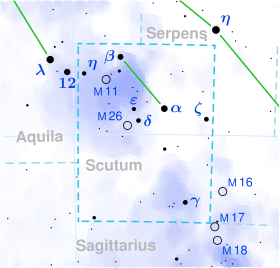
Summary
Eta Scuti, Latinized from η Scuti, is a single[10] star in the southern constellation of Scutum, near the constellation border with Aquila. Eta Scuti was a latter designation of 9 Aquilae before the official constellation borders were set in 1922.[11] It is visible to the naked eye as a faint, orange-hued star with an apparent visual magnitude of +4.83.[2] This object is located approximately 213 light-years from the Sun based on parallax, and is moving closer with a radial velocity of −92 km/s.[1]
| Observation data Epoch J2000 Equinox J2000 | |
|---|---|
| Constellation | Scutum |
| Right ascension | 18h 57m 03.67027s[1] |
| Declination | −5° 50′ 46.7305″[1] |
| Apparent magnitude (V) | 4.83[2] |
| Characteristics | |
| Evolutionary stage | horizontal branch[3] |
| Spectral type | K1-III[4] |
| U−B color index | +1.02[5] |
| B−V color index | +1.08[5] |
| Astrometry | |
| Radial velocity (Rv) | −92.22±0.16[1] km/s |
| Proper motion (μ) | RA: +61.545[1] mas/yr Dec.: −41.429[1] mas/yr |
| Parallax (π) | 15.2960 ± 0.1740 mas[1] |
| Distance | 213 ± 2 ly (65.4 ± 0.7 pc) |
| Absolute magnitude (MV) | 0.87[2] |
| Details | |
| Mass | 1.50[6] M☉ |
| Radius | 11.97+0.18 −0.13[1] R☉ |
| Luminosity | 62.7±0.8[1] L☉ |
| Surface gravity (log g) | 2.54[6] cgs |
| Temperature | 4,693+27 −266[1] K |
| Metallicity [Fe/H] | −0.03[6] dex |
| Rotational velocity (v sin i) | < 1.0[7] km/s |
| Age | 2.8[8] Gyr |
| Other designations | |
| Database references | |
| SIMBAD | data |
This is an aging giant star with a stellar classification of K1-III.[4] After exhausting the supply of hydrogen at its core, the star cooled and expanded until currently it has 12[1] times the girth of the Sun. It is a red clump giant, which indicates it is presently on the horizontal branch and is generating energy through core helium fusion.[3] The star is about 2.8 billion years old[8] with 1.5 times the mass of the Sun.[6] It is radiating 63[1] times the Sun's luminosity from its swollen photosphere at an effective temperature of 4,693 K.[1]
References edit
- ^ a b c d e f g h i j k l m Brown, A. G. A.; et al. (Gaia collaboration) (August 2018). "Gaia Data Release 2: Summary of the contents and survey properties". Astronomy & Astrophysics. 616. A1. arXiv:1804.09365. Bibcode:2018A&A...616A...1G. doi:10.1051/0004-6361/201833051. Gaia DR2 record for this source at VizieR.
- ^ a b c Anderson, E.; Francis, Ch. (2012). "XHIP: An extended hipparcos compilation". Astronomy Letters. 38 (5): 331. arXiv:1108.4971. Bibcode:2012AstL...38..331A. doi:10.1134/S1063773712050015. S2CID 119257644. Vizier catalog entry
- ^ a b Alves, David R. (August 2000), "K-Band Calibration of the Red Clump Luminosity", The Astrophysical Journal, 539 (2): 732–741, arXiv:astro-ph/0003329, Bibcode:2000ApJ...539..732A, doi:10.1086/309278, S2CID 16673121.
- ^ a b Keenan, Philip C.; McNeil, Raymond C. (1989). "The Perkins catalog of revised MK types for the cooler stars". The Astrophysical Journal Supplement Series. 71: 245. Bibcode:1989ApJS...71..245K. doi:10.1086/191373.
- ^ a b Mallama, A. (2014). "Sloan Magnitudes for the Brightest Stars". The Journal of the American Association of Variable Star Observers. 42 (2): 443. Bibcode:2014JAVSO..42..443M.Vizier catalog entry
- ^ a b c d Reffert, Sabine; Bergmann, Christoph; Quirrenbach, Andreas; Trifonov, Trifon; Künstler, Andreas (2015). "Precise radial velocities of giant stars". Astronomy & Astrophysics. 574: A116. arXiv:1412.4634. Bibcode:2015A&A...574A.116R. doi:10.1051/0004-6361/201322360. hdl:10722/215277. S2CID 59334290. Vizier catalog entry
- ^ De Medeiros, J. R.; Alves, S.; Udry, S.; Andersen, J.; Nordström, B.; Mayor, M. (2014). "A catalog of rotational and radial velocities for evolved stars". Astronomy & Astrophysics. 561: A126. arXiv:1312.3474. Bibcode:2014A&A...561A.126D. doi:10.1051/0004-6361/201220762. S2CID 54046583. Vizier catalog entry
- ^ a b da Silva, L.; et al. (November 2006), "Basic physical parameters of a selected sample of evolved stars", Astronomy and Astrophysics, 458 (2): 609–623, arXiv:astro-ph/0608160, Bibcode:2006A&A...458..609D, doi:10.1051/0004-6361:20065105, S2CID 9341088
- ^ "eta Sct". SIMBAD. Centre de données astronomiques de Strasbourg. Retrieved 2019-08-23.
- ^ Eggleton, P. P.; Tokovinin, A. A. (September 2008), "A catalogue of multiplicity among bright stellar systems", Monthly Notices of the Royal Astronomical Society, 389 (2): 869–879, arXiv:0806.2878, Bibcode:2008MNRAS.389..869E, doi:10.1111/j.1365-2966.2008.13596.x, S2CID 14878976.
- ^ Wagman, M. (August 1987). "Flamsteed's Missing Stars". Journal for the History of Astronomy. 18 (3): 213. Bibcode:1987JHA....18..209W. doi:10.1177/002182868701800305. S2CID 118445625.



